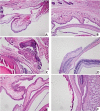Effects of Topical Thymoquinone in an Experimental Dry Eye Model
- PMID: 30605933
- PMCID: PMC6330663
- DOI: 10.4274/tjo.50146
Effects of Topical Thymoquinone in an Experimental Dry Eye Model
Abstract
Objectives: To comparatively evaluate the effects of thymoquinone (TQ), the biologically active main component of volatile oil derived from Nigella sativa seeds, in an experimental dry eye model.
Materials and methods: A total of 36 BALB/c mice 10 weeks of age were used in the study. The mice were divided into 6 groups of 6 mice. Two groups were negative and positive controls, and the other 4 groups were treated with balanced salt solution, fluorometholone (FML), TQ, or vehicle (Tween80). After 1 week of treatment, the mice were killed and the eyes removed for histopathologic examination and cytokine analysis. Interleukin (IL)-1α tumor necrosis factor-α, interferon-γ, IL-2, IL-6, IL-10, and lactoferrin levels in the conjunctival tissue were measured by multiplex immunobead assay. The presence of inflammatory cells in ocular tissue samples were investigated by hematoxylin-eosin and periodic acid-Schiff staining. Inflammatory T cells containing CXT receptor in the conjunctiva were determined by flow cytometry.
Results: FLML and TQ groups had less inflammatory cell density and more goblet cells compared to the other groups. High levels of IL-1α and IL-2 were found in the TQ group.
Conclusion: TQ treatment was associated with reduced inflammation in pathological examination, but did not significant lower cytokine levels.
Keywords: Black seed oil; dry eye; thymoquinone.
Conflict of interest statement
Figures

References
-
- Al-Ghamdi MS. The anti-inflammatory, analgesic and antipyretic activity of Nigella sativa. J Ethnopharmacol. 2001;76:45–48. - PubMed
-
- Barabino S, Rolando M, Camicio P, Ravera G, Zanardi S, Giuffrida S, Calabria G. Systemic linoleic and gamma-linolenic acid Systemic therapy in dry eye syndrome with an inflammatory component. Cornea. 2003;22:97–101. - PubMed
-
- Bourcier T, De Saint-Jean M, Brignoli F, Goguel A, Baudouin C. Expression of CD40 and CD40 ligand in the human conjunctival epithelium. Invest Ophthalmol Vis Sci. 2000;41:120–126. - PubMed
-
- Brignoli F, Piselli PJ, Desaint Jean M, Goldschild M, Goguel A, Baudouin C. Flow cytometric analysis of inflammatory markers in KCS: 6-month treatment with topical cyclosporine A. Invest Ophthalmol Vis Sci. 2001;42:90–95. - PubMed
-
- No authors listed. Flow cytometric analysis of inflammatory markers in conjunctival epithelial cells in patients with dry eyes. Brignole F, pisella P-J, goldschild M, De saint jean M, goguel A, baudouin C.* invest. ophthalmol vis sci. 2000;41:1356–1363. - PubMed
MeSH terms
Substances
LinkOut - more resources
Full Text Sources
Other Literature Sources
